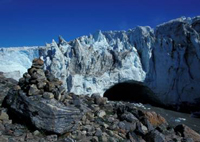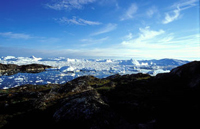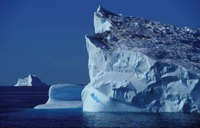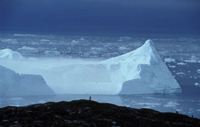

The Destination ...
Gunnbjoerns Fjell
With its 3700 meters of altitude it is not only the highest elevation of Greenland, but also the largest mountain of the northern polar area. The Gunnbjoerns Fjell (named after the Viking Gunnbjoern, who discovered the island around 875) is situated 75 kilometers northwest of Cape Garde in the still nearly unexplored Watkins mountains (named after Henry George " Gino " Watkins, an Englishman, who participated 1930-31 in the Arctic air route expedition).
Despite an often men life-hostile environment the largest island of the world, however always exercised a strong attraction on humans. There were above all sailors, polar travellers and mountain climbers, who travelled and investigated Greenland more intensively. Fridtjof Nansen, Einar Mikkelsen, Robert Peary, Knut Rasmussen, Alfred Wegener, Reinhold Messner and Arved Fuchs, to name only some, belong to the most famous polar travelers of the present. They all were lured to Greenland either by scientific interests or sporty ambitions, equally fascinated by the isolation and naturalness of this unique unspoiltlandscape of ice and rock. No wonder that over the last years Greenland has also become the center of attraction for canoing, experienced Trekkers and mountain climbers. Especially the south and east coast of the island offer a large extensive area (over 3000 km) of unexplored ground and mountains with imposing formations of granite and gneiss, between which the inland ice clears its way to the sea in enormous glaciers.
Greenland in General:
Surface: 2,166,086 qkm. Total population: 56,124,083 (2000). Population density: 0.026 per qkm. Capital: Nuuk (formerly Godthåb). Inhabitants: 13,169 (1999).
Geography:
Greenland is the largest island of the world (taking Australia as a continent ). The sea is either permanently frozen or cooled down by the meeting of the Arctic Ocean and the North Atlantic. The inland consists of an ice sheet, which extends from north to south over 2500 km and from east to west over 1000 km and which is partly up to 3 km thick. The oldest ice sheets are approx. two million years old. The ice-free coastal region which may be up to 200 km wide covers 341,700 qkm; the entire population live here. This area is furrowed by deep fjords, which connect the ice in the inland with the sea. The midnight sun shines north of the polar circle. During the long arctic winter night twilight prevails, and in the north of the country it is completely dark. The northern lights can be seen in autumn, winter and at the beginning of spring. In the south the polar lights may be seen from the end of August onward.



